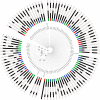How To Live with Phosphorus Scarcity in Soil and Sediment: Lessons from Bacteria
- PMID: 27235437
- PMCID: PMC4984279
- DOI: 10.1128/AEM.00160-16
How To Live with Phosphorus Scarcity in Soil and Sediment: Lessons from Bacteria
Abstract
Phosphorus (P) plays a fundamental role in the physiology and biochemistry of all living things. Recent evidence indicates that organisms in the oceans can break down and use P forms in different oxidation states (e.g., +5, +3, +1, and -3); however, information is lacking for organisms from soil and sediment. The Cuatro Ciénegas Basin (CCB), Mexico, is an oligotrophic ecosystem with acute P limitation, providing a great opportunity to assess the various strategies that bacteria from soil and sediment use to obtain P. We measured the activities in sediment and soil of different exoenzymes involved in P recycling and evaluated 1,163 bacterial isolates (mainly Bacillus spp.) for their ability to use six different P substrates. DNA turned out to be a preferred substrate, comparable to a more bioavailable P source, potassium phosphate. Phosphodiesterase activity, required for DNA degradation, was observed consistently in the sampled-soil and sediment communities. A capability to use phosphite (PO3 (3-)) and calcium phosphate was observed mainly in sediment isolates. Phosphonates were used at a lower frequency by both soil and sediment isolates, and phosphonatase activity was detected only in soil communities. Our results revealed that soil and sediment bacteria are able to break down and use P forms in different oxidation states and contribute to ecosystem P cycling. Different strategies for P utilization were distributed between and within the different taxonomic lineages analyzed, suggesting a dynamic movement of P utilization traits among bacteria in microbial communities.
Importance: Phosphorus (P) is an essential element for life found in molecules, such as DNA, cell walls, and in molecules for energy transfer, such as ATP. The Valley of Cuatro Ciénegas, Coahuila (Mexico), is a unique desert characterized by an extreme limitation of P and a great diversity of microbial life. How do bacteria in this valley manage to obtain P? We measured the availability of P and the enzymatic activity associated with P release in soil and sediment. Our results revealed that soil and sediment bacteria can break down and use P forms in different oxidation states and contribute to ecosystem P cycling. Even genetically related bacterial isolates exhibited different preferences for molecules, such as DNA, calcium phosphate, phosphite, and phosphonates, as substrates to obtain P, evidencing a distribution of roles for P utilization and suggesting a dynamic movement of P utilization traits among bacteria in microbial communities.
Copyright © 2016, American Society for Microbiology. All Rights Reserved.
Figures




References
-
- Elser JJ, Bracken MES, Cleland EE, Gruner DS, Harpole WS, Hillebrand H, Ngai JT, Seabloom EW, Shurin JB, Smith JE. 2007. Global analysis of nitrogen and phosphorus limitation of primary producers in freshwater, marine and terrestrial ecosystems. Ecol Lett 10:1135–1142. doi: 10.1111/j.1461-0248.2007.01113.x. - DOI - PubMed
Publication types
MeSH terms
Substances
LinkOut - more resources
Full Text Sources
Other Literature Sources
Miscellaneous

